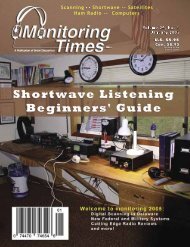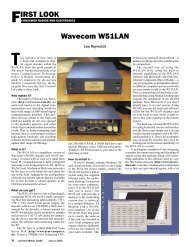RIGHT-click here - Monitoring Times
RIGHT-click here - Monitoring Times
RIGHT-click here - Monitoring Times
Create successful ePaper yourself
Turn your PDF publications into a flip-book with our unique Google optimized e-Paper software.
A number of novel technologies are being<br />
tested on board the satellite including a thin<br />
film solar cell experiment and an autonomous<br />
wireless sun sensor experiment.<br />
Delfi-C-3 was successfully launched on<br />
April 28th, 2008 at 03:54 UTC on a PSLV<br />
launch vehicle from the Satish Dhawan Space<br />
Center in India. As of this writing, Delfi-3C<br />
was still operational with a telemetry (science)<br />
beacon downlink centered on 145.870 MHz.<br />
However, its linear uplink and downlink analog<br />
transponders, although activated soon after<br />
launch, were not operational. The latest status<br />
of the satellite can be found on the Delfi-C3<br />
Web site at: www.delfic3.nl.<br />
❖ FO-69 and FO-70<br />
(Fastrac-1 and 2)<br />
Fastrac-1 and 2 are a pair of student-built<br />
nanosatellites from the University of Texas<br />
at Austin (USA) built to investigate relative<br />
navigation, attitude determination with GPS,<br />
and a micro-discharge plasma thruster. After<br />
their primary science missions are completed<br />
(and assuming they survive that long!) one<br />
or both satellites may be opened for general<br />
amateur Radio use as digipeaters using 1200<br />
and 9600 Baud packet radio.<br />
Fastrac 1 and 2 undergoing final electronic<br />
testing prior to launch (Courtesy: University<br />
of Texas at Austin)<br />
Fastrac-1 and 2 were successfully launched<br />
by a Minotaur launch vehicle from the Kodiak<br />
Launch Complex in Alaska on November 20,<br />
2010 into a 650 km circular orbit. At press time,<br />
the digital transponders aboard FO-69 and FO-<br />
70 were not operating, but their 2m and 70cm<br />
beacons were being transmitted.<br />
❖ (AO-70) (AubieSat-1)<br />
AubieSat-1 (AS-1) is an undergraduatebuilt<br />
CubeSat satellite developed by Auburn<br />
University in Alabama (USA). It was successfully<br />
launched into a somewhat elliptical<br />
816 X 458 km Orbit from Vandenberg AFB,<br />
California on October 28, 2011.<br />
AubieSat-1 transmits with a power of<br />
about 800 milliwatts on a downlink frequency<br />
of 437.475 MHz. The beacon signal, along<br />
with telemetry, is sent using continuous wave<br />
(CW) Morse code at about 20 words per minute.<br />
More information on the status of AO-70<br />
can be found at: www.space.auburn.edu.<br />
These are just a few of the current “flock”<br />
of small satellites that are now in orbit and<br />
available for you to hear (or, if properly licensed,<br />
to actually talk through). However,<br />
t<strong>here</strong> are many more satellites that have been<br />
recently launched than I have room to list <strong>here</strong>.<br />
An excellent chronological outline of all of<br />
our amateur satellites (listed by launch date<br />
along with their current operational status)<br />
can always be found on the AMSAT Web site<br />
at: www.amsat.org/amsat-new/satellites/<br />
history.php.<br />
SELECTED FREQUENCY AND MODE DATA<br />
SATELLITE Uplink (MHz) Downlink (MHz) Mode<br />
PW-Sat 435.020 145.900 FM / DSB<br />
DO-64<br />
(Delfi-C3)<br />
145.870 CW Telemetry Beacon<br />
Fastrac-1 145.980<br />
437.435<br />
(FO-69) 145.825<br />
9600 and 1200 Baud AX.25 Packet<br />
Fastrac-2<br />
(FO-70)<br />
AubieSat-1<br />
(AO-71)<br />
435.025<br />
437.435<br />
145. 825<br />
437.475<br />
Fastrak 1 and 2 were successfully launched<br />
by a Minotaur launch vehicle from the Kodiak<br />
Launch Complex in Alaska on November 20,<br />
2010. They became FO-69 and FO-70 when<br />
they were activated on orbit. (Courtesy: University<br />
of Texas at Austin)<br />
9600 and 1200 Baud AX.25 Packet<br />
1200 Baud AX.25<br />
CW Beacon<br />
(20 WPM)<br />
The flight model of AubieSat (AO-71). (Courtesy:<br />
Auburn University)<br />
❖ Project FOX Update<br />
In my February MT column, I introduced<br />
you to AMSAT-North America’s next big project…a<br />
Cubesat design we call “FOX.” Then, in<br />
my May column, I reported that the first satellite<br />
in this series (FOX-1) had recently been<br />
selected by NASA for one of their reduced<br />
cost ElaNa launches (Educational Launch of<br />
Nanosatellites program) in the 2013-2014 time<br />
frame.<br />
Since that announcement, FOX experimenters<br />
completed an extensive Preliminary<br />
Design Review (PDR) of the entire project.<br />
During the PDR, all mechanical, RF, control,<br />
power, and related designs and issues were<br />
extensively discussed. The current status of<br />
the project was also evaluated, and the need<br />
for further development for various systems<br />
and subsystems was refined. AMSAT’s Vice<br />
President for Engineering Tony Monteiro,<br />
AA2TX, characterized the review as, “Very<br />
productive.”<br />
AMSAT is now working with NASA on a<br />
detailed collaborative agreement for the launch<br />
of the satellite. It is also important to note that<br />
FOX-1 was selected to participate in the NASA<br />
ELaNa effort based on its merit in support<br />
of NASA’s strategic and educational goals.<br />
Clearly, this recognition places AMSAT in a<br />
very good position to garner future launches<br />
for its satellites under the ElaNA program.<br />
AMSAT’s Fox-1 project timeline is based<br />
on an anticipated launch for the satellite in the<br />
second half of 2013. However, NASA will<br />
determine on which specific flight each of the<br />
Project ELaNa CubeSats is carried to orbit.<br />
So, the launch timeline for FOX-1 could very<br />
well slip…or be accelerated… depending on<br />
NASA’s other launch needs. In the interim, the<br />
latest on FOX-1’s status can be found on the<br />
FOX-1 Web page at: www.amsat.org/amsatnew/fox/.<br />
❖ Looking Ahead<br />
That’s all for this time. Clearly, it’s a very<br />
exciting time for amateur radio in space. In<br />
future columns, I’ll bring you up-to-date on<br />
the progress of the FOX-1 effort as well as the<br />
status of some of our other amateur satellites<br />
still in orbit. I’ll also highlight some exciting<br />
amateur satellite projects that are now on<br />
AMSAT’s drawing boards. See you then!<br />
August 2012 MONITORING TIMES 67
















